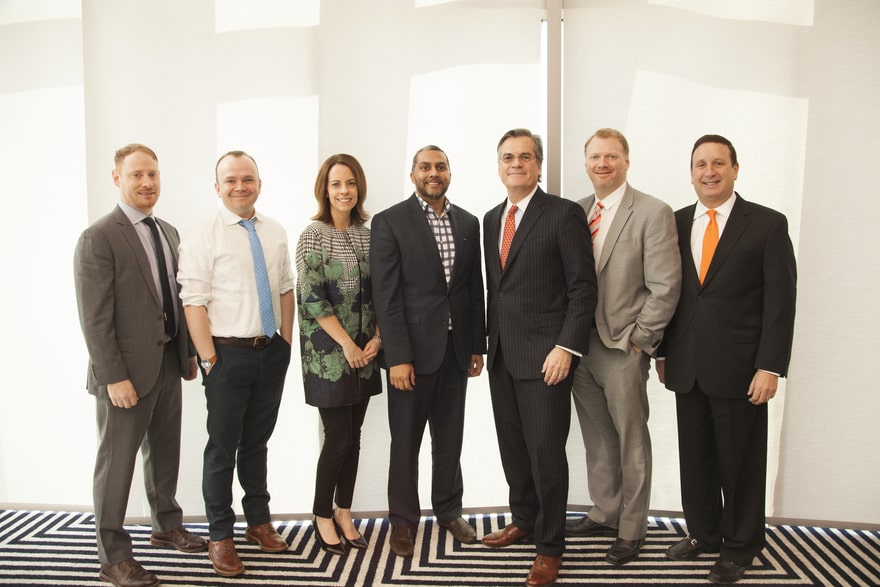
 From left: David Eisen, editor-in-chief of Hotel Management magazine; Alex Gallafent, design director at international design and consulting firm IDEO; Jen Gribble, VP of Avid Hotels and Holiday Inn Express at InterContinental Hotels Group; Mitesh Patel, president of Paragon Hotel Company; Mark Woodworth, senior managing director at CBRE Hotels; Chris Drazba, VP of core brand development at IHG; and Peter Berk, founder of PMZ Realty Capital.
From left: David Eisen, editor-in-chief of Hotel Management magazine; Alex Gallafent, design director at international design and consulting firm IDEO; Jen Gribble, VP of Avid Hotels and Holiday Inn Express at InterContinental Hotels Group; Mitesh Patel, president of Paragon Hotel Company; Mark Woodworth, senior managing director at CBRE Hotels; Chris Drazba, VP of core brand development at IHG; and Peter Berk, founder of PMZ Realty Capital.A flurry of new brands has pushed the midscale space back into the spotlight, highlighting the segment’s strong return on investment potential for owners. Hotel Management’s Midscale Roundtable, sponsored by InterContinental Hotels Group, brought six industry insiders together to discuss the ins and outs of the midscale space and what it will take to become a leader there in 2018.
The midscale space is attractive for a number of reasons, but Jen Gribble, VP of Avid Hotels and Holiday Inn Express at InterContinental Hotels Group, said her company has identified 14 million travelers that it describes as “underserved” by existing midscale supply—an untapped reservoir of customers representing $20 billion in annual revenue. This realization is what led IHG to launch Avid last September.
Chris Drazba, VP of core brand development at IHG, agreed, stating that opportunities in midscale stem from the segment’s leaders relying on a conversion-heavy method as opposed to one rooted in new construction. “There’s an opportunity for a new-construction brand like Avid Hotels… to come in and build something ground up, and have it bring better consistency to the overall brand space,” Drazba said.
Now seems like a good time to get in on the midscale action. Peter Berk, founder of PMZ Realty Capital, said financing for midscale hotel development is relatively easy to come by right now, primarily because investors perceive midscale hotels as assets with a high return on investment and lower risk when compared to hotels in other segments.
“When we approach banks, it’s easier to underwrite a loan when you can look at the [revenue per available room] of similar hotels and see how your hotel’s going to do rather than looking at hotels that are heavy on group business or a lot of [food-and-beverage],” Berk said. “There’s a lot more lenders interested because they’re somewhat easier to underwrite.”
Part of what excites developers about a midscale hotel boom is the comparatively smaller footprint many of these properties require. Mitesh Patel, president of Paragon Hotel Company, said all that is needed to develop a 42,000-square-foot, 95-room midscale hotel is 1.5 acres of land. To put it succinctly, that’s a bullseye many hoteliers and developers are aiming for.
“From an operational perspective, when you’re managing and owning these types of assets, you’re seeing very high departmental percentage profits leading into net operating incomes probably in the 30th percentile,” Patel said. “That midscale perspective, at this moment, looks like a sweet spot.”
Midscale hotels also come packaged without many of the frills found in upscale properties. Alex Gallafent, design director at design and consulting firm IDEO, which was instrumental in the Avid brand’s development, said the goal in the midscale category is to simplify guestroom design as a means to maintain quality over time, at the price point these hotels operate at.
“One way to think about it is removing opportunities for guests to be anxious or disappointed,” Gallafent said. “With the [Avid] brand, [guests] will have a greater degree of confidence… that what they encounter is what they expect.”
Gribble’s earlier estimation that 14 million underserved travelers exist in the midscale segment is most significant because it means hotels have continued to underserve midscale travelers for some time. Because of this, Gribble said IHG has spent a great deal of time getting to know this target audience so that the company’s next midscale product would be on target. “There’s a profile of those guests,” Gribble said. “General possible income, general age and other things that matter a little more. So we’re not just talking. We want to make sure that we’re talking about the target.”
Gallafent said midscale guests aren’t necessarily frugal, but wasteful spending is something they avoid. Knowing this, Gallafent said midscale travelers will spend more on special occasions as long as they are getting the product or service they are looking for.
“[These guests] are looking for a place where they don’t have to compromise on cost,” he said. “They’re not going to be taking a risk.”
 From left: Alex Gallafent, design director at IDEO, and Jen Gribble, VP of Avid Hotels and Holiday Inn Express at InterContinental Hotels Group, discuss the profile of the midscale traveler and how the industry can better serve the segment’s needs.IHG’s Drazba (center) said midscale hotels are popular in airport markets for a variety of factors, but primarily because of the captive audience as a result of air travel. He’s flanked by CBRE’s Woodworth and PMZ’s Berk.
From left: Alex Gallafent, design director at IDEO, and Jen Gribble, VP of Avid Hotels and Holiday Inn Express at InterContinental Hotels Group, discuss the profile of the midscale traveler and how the industry can better serve the segment’s needs.IHG’s Drazba (center) said midscale hotels are popular in airport markets for a variety of factors, but primarily because of the captive audience as a result of air travel. He’s flanked by CBRE’s Woodworth and PMZ’s Berk.According to Mark Woodworth, senior managing director at CBRE Hotels, the hotel industry continues to achieve record occupancy levels each year in a manner that seems sustainable for the foreseeable future. Because of this, he said now is the time to build based on the fact that new hotels are almost always more successful than older properties.
“If you can have something new for the same price as something old, you’re going to adopt the new, not only because it’s new but it probably reflects something that has been designed to meet your preferences, things that you’re looking for,” Woodworth said.
In looking at historic census data, Woodworth pointed out a high degree of conversions in the midscale space dating back to 2014. He suspects, based on other data from that period, that many of these hotels converted to the economy segment, and little new construction has stepped in since then to fill the void. “We think it portends terrific opportunity,” Woodworth said. “We think the development economics and the operating economics are going to make the capital sources like this product, so I would expect that [midscale] is going to do very well.”
 IHG’s Drazba (center) said midscale hotels are popular in airport markets for a variety of factors, but primarily because of the captive audience as a result of air travel. He’s flanked by CBRE’s Woodworth and PMZ’s Berk.
IHG’s Drazba (center) said midscale hotels are popular in airport markets for a variety of factors, but primarily because of the captive audience as a result of air travel. He’s flanked by CBRE’s Woodworth and PMZ’s Berk.If you’re thinking about building a midscale hotel, but you aren’t sure where, Woodworth said to “follow the capital.” He pointed to the many markets around the U.S. where airports are directly investing money into new terminals and new hotel development at the same time, setting the stage for future demand while planning to accommodate it ahead of time. But those aren’t the only hot markets.
“We’re looking for college university markets, in addition to high corporate leisure markets that are adjacent to highways, interstates and airports,” Patel said. “With the amount of square footage requirements, in addition to the efficiencies of operations, this seems like a good niche to be involved with.”
According to Drazba, much of the early interest in IHG’s Avid brand was focused on airport markets, a decision made very much on purpose. “A hotel that plays with an upscale chain may not want [airline] crew business or distressed passengers,” Drazba said. “You don’t feel bad about that with a midscale brand, especially when you are looking to build occupancy.”
Acceptance of basic operational challenges associated with these markets is part of the development story, but the availability of investment dollars is another issue. Berk said that in 2017 the hotel industry pulled off $100 billion in commercial-mortgage-backed securities transactions. This is more than what was spent on CMBS deals in 2016, which is notable because banks previously targeted hotels for CMBS loans due to the fact that hotels typically were perceived as risky assets. Times are changing though, and now retail developments are considered riskier than hotels. In the end, it’s hotels that stand to gain.
“Hotels are considered risky because every night you reprice yourselves, as opposed to an office building,” Berk said. “So [lenders] got to charge more for doing hotels as opposed to other asset types, and they would only take about 10 percent in any one CMBS pool. Fast-forward to today… that ugly stepchild is retail.
“Now, all of a sudden, CMBS lenders [price] retail a little higher and lenders are taking 15 [percent] to 20 percent of their total pools as hotels and are pricing less than retail.”
 Mitesh Patel, president of Paragon Hotel Company, far right, lamented a dearth of subcontractors and general contractors. Next to him are IHG’s Jen Gribble and IDEO’s Alex Gallafent.
Mitesh Patel, president of Paragon Hotel Company, far right, lamented a dearth of subcontractors and general contractors. Next to him are IHG’s Jen Gribble and IDEO’s Alex Gallafent.Drazba said IHG began development on the first property in the Avid brand in December in Oklahoma City, with 34 more signed deals and 100 applications waiting behind it.
It’s a promising start for a new brand in an industry choked with new brands, which could point to the promise of success lying within the midscale market.
“The interest level has been quite high, and I think we’re looking to carry that momentum into 2018,” Drazba said.
Patel lamented a lack of subcontractors and general contractors as an issue that hopeful hotel developers may have to contend with in 2018, as well as regulatory issues slowing down the development process, but he shares Drazba’s optimism.
“Other than that, it looks like 2018 and 2019 are going to both be good years,” Patel said.
Woodworth said he believes we are currently in a golden age for travel, and it’s time others operating within the space see it in the same light.
He likened the current environment to the late 1970s and early 1980s when women began entering the workforce in droves and started traveling. The industry was confronted with new members of the public who were looking for lodging, which resulted in the segmentation that exists within the industry today.
“When I think of the phrase ‘golden age,’ I think of something that is good, and doesn’t happen very often,” he said. “I do think we’re going to look back and see this was a really important turning point, not just domestically but globally, in terms of travel.”
This article originally appeared in Hotel Management on February 28, 2018